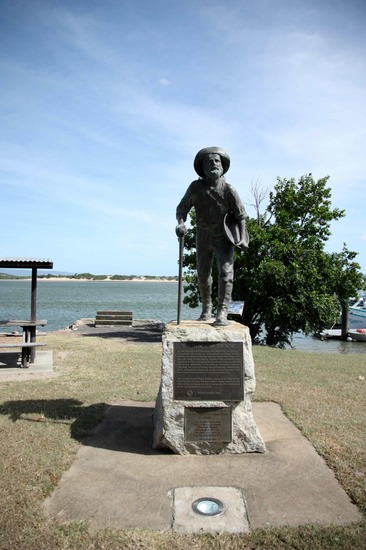 Mulligan reached the Palmer on 29 June, struck payable gold on 12 August and was back in Georgetown, the centre of the Etheridge Goldfield, on 3 September with 102 ounces of gold (that's just under three kilograms in the new money, folks). Mulligan stayed on the Etheridge just long enough to report the find and collect fresh supplies. News of his discovery had a hundred men and three hundred horses heading out of the Etheridge with Mulligan in September 1873.
Mulligan reached the Palmer on 29 June, struck payable gold on 12 August and was back in Georgetown, the centre of the Etheridge Goldfield, on 3 September with 102 ounces of gold (that's just under three kilograms in the new money, folks). Mulligan stayed on the Etheridge just long enough to report the find and collect fresh supplies. News of his discovery had a hundred men and three hundred horses heading out of the Etheridge with Mulligan in September 1873.
Do the sums yourself. At today's gold prices, three kilograms (let's keep things in round figures here) would be worth something in the order of one and a half million dollars.
The Queensland Government, in their constant quest for things that would create revenue, had commissioned an expedition with George Elphinstone Dalrymple in charge to sail north from Cardwell and investigate prospects along the coast between Rockingham Bay and the Endeavour.
Dalrymple had two small cutters, the Flying Fish and the Coquette, a party that was heavy on Native Mounted Police, and instructions to check out the countryside and link up with a party that would head down from the Palmer headed by his old mate Philip Sellheim.
Dalrymple and Sellheim went way back, at least as far back as the declaration of the Kennedy Pastoral district on 1 January 1861. Dalrymple had been appointed Lands Commissioner for the new district and held a little New Years party for selected friends to allow them to select prime real estate straight off the map, sight, more or less unseen (you'll find the actual details in Jean Farnfield's Frontiersman: a biography of George Elphinstone Dalrymple, assuming you can track down a copy).
In any case Dalrymple set off with his two cutters loaded with Native Police, took a good look at things along the way and ended up landing in the Endeavour River on 24 October 1873. The two vessels weren't large enough for the party to sleep on board, so once they'd reached the destination they started unpacking the following morning, preparing to settle in until Sellheim arrived on the scene and the Native Police contingent could head up to the Palmer.
They were in the middle of setting up camp the following morning when the masts of a ship appeared above the mangroves at the mouth of the river and shortly thereafter Dalrymple learned of a change of plan. The Government had changed its mind, told Sellheim to hold his horses, and chartered the steamer Leichhardt to carry newly appointed Goldfield Commissioner Howard St George, engineer Archibald Macmillan assorted officials and seventy-nine miners to the Endeavour and have them blaze a trail from the port to the goldfield rather than from field to port.
So, knowing the story, once we'd arrived in Cooktown, the obvious first item on the agenda was breakfast, and the most likely source was Charlotte Street, which conveniently runs past the points where Cook beached the Endeavour, Dalrymple set up his camp and the Macmillan party landed.
And the obvious thing to do after breakfast was to take a stroll along the main drag, scope out the town and see whether I could visualise the events of 25 October 1873. More...